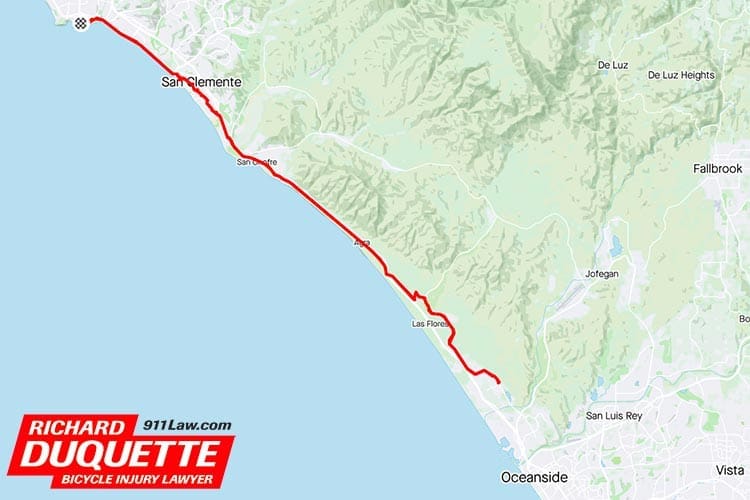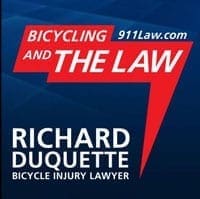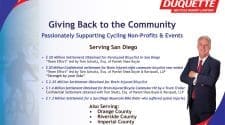By Richard Duquette, Esq, Law Firm of Richard Duquette
Listen to the Podcast
Reconstructing a bicycle crash is growing increasingly scientific these days. Here are a few observations on ways to counter insurance company tactics that attempt to deny or reduce the value of your bicycle claim.
Using a GPS device can help you establish the general point of impact of a crash. I say the general point of impact because the data from the downloaded GPS will give you basic locations details, similar to a black box in an airplane crash. You will have to support the GPS data with other evidence to establish the point of impact.
Here are a few ways to accomplish this, and why:
The point of impact in a crash is often relevant to prove you, the bicyclist, were acting lawfully, i.e., in the right place in the road and for the right reasons. In injury cases, this could mean the difference between winning or losing, or defeating an accusation of contributory fault levied by an insurance company, which may reduce your lawful recovery.
Downloading the GPS data to Google Maps will show generally where the collision occurred, and add credibility to your claim. The GPS will show your direction of travel and ride history. Using Google Earth and ground scene photos, you can paint an accurate picture of the crash site, using incremental time images. Items to look for are traffic signals and signage, which correspond with the ending GPS signal. This is evidence that you stopped, and obeyed the law. Further, the GPS may show that on earlier rides on the subject route, you complied with traffic signals as a lawful and safe bicyclist.
Combine the GPS signal with your data from a cyclometer that shows slowing, speed, pedaling cadence, and heart rate will also support that you stopped for signage.
If the exact location on the road is still needed, like a bus versus bicycle side-swipe case I successfully settled, physical evidence will be needed. This includes gouge marks in the asphalt roadway, skid marks, lane markers, manhole covers, and other measurements. With this further evidence, an accident reconstructionist can use computerized survey equipment to input the measurements of the location of these items into a “total station” computer program, then generate a computer-aided design (CAD) and a resulting map. This is often further supported by an animated graphic to demonstrate the reconstructed view of the crash.
Retaining an expert reconstructionist to perform this work is extremely costly. Your GPS reconstruction can help you avoid this costly process and avoid being “priced out” of justice, a common tactic of the insurance industry.
The increasing use of digital cameras by some bicyclists on their helmets and handlebars is another effective tool to support your GPS evidence, as photographic images can prove your lawful riding and the point of impact. Bicyclists should note that buses digitally record the driver’s front, side and interior views of the bus in case of a crash. The device records multiple images at one-second intervals, allowing a post-accident analysis of the bus operator’s driving and the position of the bus in relation to a bicycle.
On a civil liberty note, the United States Supreme Court issued a decision in U.S. v. Jones, a case where the police attached a GPS tracking device to a suspect’s car to detect the suspect’s whereabouts for weeks, implicating 4th Amendment illegal search and seizure issues. In contrast, an individual can now obtain a GPS application on a phone to track friends with their consent.
The use of a GPS to substantiate your claim can be critical. It can also help you calculate the time it took an offending vehicle to travel a specific distance. This can prove excessive speed, unlawful driving, or illegal lane changes made in a short distance.
As a bicyclist, take photos of the chainring and gear of your bicycle at the time of impact. Photograph the large chainring and the rear cluster to show the position of your chain, and then correlate it to a speed chart or matrix. This evidence, in conjunction with your GPS speed, heart rate, cadence and route, (uphill, downhill, or flat), will corroborate your riding was lawful, i.e., in compliance with the posted speed limit, basic speed laws, or not obstructing the flow of traffic in your lane.
Moreover, GPS and physical evidence can be used successfully in the event a bicyclist sustains a head injury. Often, the bicyclist goes down and loses consciousness. Memory is often affected, but the GPS and the physical evidence can help effectively reconstruct the crash scene, helping to prove the victim’s case. This will also support favorable witness testimony, like friends that were on the ride, thereby helping to objectively defeat insurance claims of “biased testimony by fellow bicyclists.”
So, get a GPS for fun and protection. It’s a small price to pay for the wealth of data evidence that can be gained when you need it most.
If you’re injured, hire an experienced trial attorney.
Ride Safe, Ride Strong!
Richard L. Duquette
About the Law Firm of Richard L. Duquette
The Law Firm of Richard Duquette has recovered millions in damages for injured bicyclists since 1983. Attorney Duquette is an experienced bicyclist himself and has dedicated his practice to helping this community. He is experienced in all types of cases involving bicycle crashes, injuries, and other legal troubles.
Mr. Duquette serves a wide variety of bicyclists. Whether you prefer road cycling, mountain biking, track riding, Randonneuring, E-Bicycles, Handcycles, Century Rides, Triathlons, Duathlons, or Criterium, Mr. Duquette knows how to best serve your legal needs regardless of the type of bicyclist you are.
Mr. Duquette is an expert at maximizing, proving, and recovering damages.
For more information please visit the Law Firm of Richard Duquette.
The information in this article is for general information purposes only. The focus of this article is on California Law. You should contact an attorney in your state for case-specific advice, as details of the law and procedural requirements vary from state to state. Nothing in this article should be taken as legal advice for any individual case or situation. This information is not intended to create an attorney-client relationship; and the receipt, reading, listening, or viewing of this content shall not constitute an attorney-client relationship. Nothing in this article shall be construed as a warrant, promise, or guarantee about the outcome of your case or any other matter. This information may contain personal impressions or statements of opinion on a subject that do not apply in your case. Further, statements of law reflect the current state of the law at the time of writing and/or recording, and may not reflect subsequent changes in the law.




















